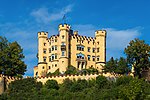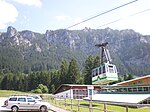Schwangau

Schwangau is a municipality in the district of Ostallgäu in Bavaria, Germany. The village lies 4 km from the larger town of Füssen and just 1.5 km from Hohenschwangau, a collection of tourist-oriented facilities adjacent to the major tourist attractions of Schloss Neuschwanstein and Schloss Hohenschwangau. Schwangau has no railway station, but is served by buses connecting to Füssen, Hohenschwangau, and other nearby Alpine towns. It is the next-to-last town on the Romantic Road tourist route that terminates in Füssen. A castrum Swangowe is attested in 1090. It was situated on the site of Neuschwanstein Castle and was owned by the Elder House of Welf. After the death of Welf VI in 1191, it fell to the Staufer dynasty, and in 1268 to the empire. The coat of arms of the municipality is based on the one shown in the Codex Manesse as that of Hiltbolt von Schwangau (d. 1256).
Excerpt from the Wikipedia article Schwangau (License: CC BY-SA 3.0, Authors, Images).Schwangau
König-Ludwig-Straße,
Geographical coordinates (GPS) Address Nearby Places Show on map
Geographical coordinates (GPS)
| Latitude | Longitude |
|---|---|
| N 47.583333333333 ° | E 10.733333333333 ° |
Address
König-Ludwig-Straße 54 a
87645
Bavaria, Germany
Open on Google Maps










